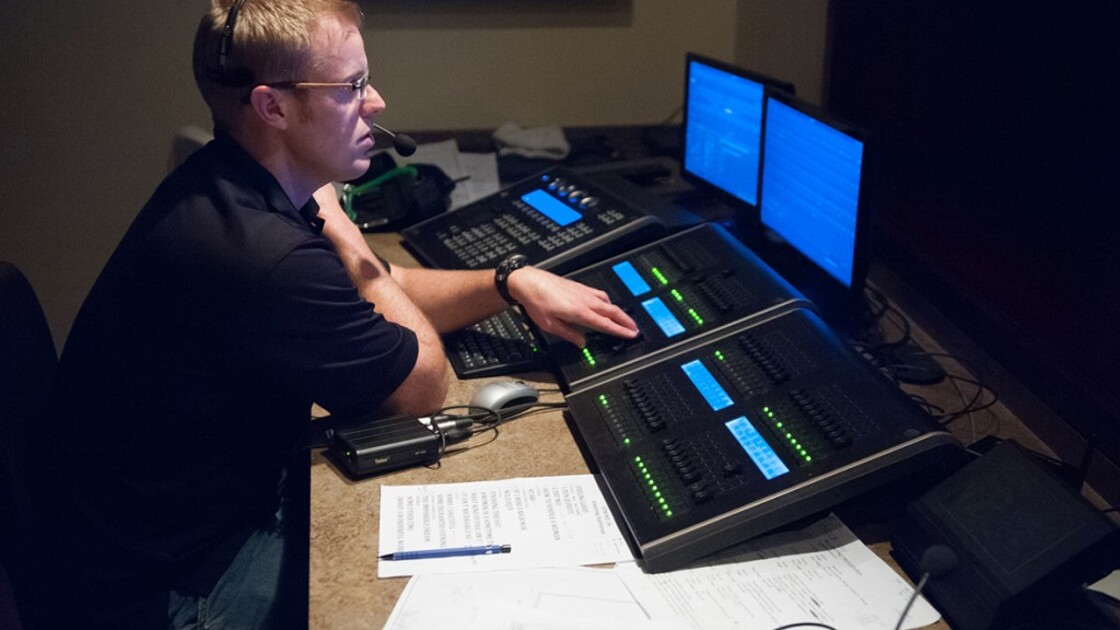EDMOND—As hundreds of concertgoers stream into Armstrong Auditorium tonight to see Brian Stokes Mitchell, there are dozens of people working behind the scenes to make sure they see a good show. One of those men behind the curtains—or in his case, behind the glass—is lighting engineer David Weeks.
Dozens of award-winning performers at the top of their art have already stepped out on the Armstrong Auditorium stage. But before any of them can put on a quality show, someone has to put in dozens of hours of intricate, precise work, just to get the lighting right.
Weeks and his assistant, Herbert W. Armstrong College senior Bailey Crawford, spend hours on the auditorium stage, in its rafters and in the lighting booth to prepare for productions. Some of the more intensive lighting requirements have been for major productions like the pcg’s David musical in December and January’s performances of Sleeping Beauty and Don Quixote by the Moscow Festival Ballet.
For David, Weeks spent more than 120 hours preparing the auditorium’s approximately 230 stage lights. It was the most complex lighting requirement he and Crawford have facilitated to date. To prepare for the musical, and to learn how to do a job he had no prior experience in, Weeks took a trip to a leading theater in Missouri.
“I got to meet a professional lighting engineer and walked around their set asking questions for about two hours,” he said. “Combining that with actually seeing the show was very helpful.” In that production, the theater employed scrims: thin, translucent screens that can be used as veils or to project text. After Weeks relayed how the equipment enhanced the production, the Church purchased two scrims that were used for the David musical and are available for future concerts.
“When they’re lit correctly, they become opaque, and you can’t see what’s going on behind it, which enables them to change the scene behind the scrim while something is going on in front of it,” Weeks explained. “The best part is the ability to then do the ‘reveal,’ where you light behind the scrim, and then you can see right through, and you see a new scene.” In the past, concert-series performers have requested scrims, but the auditorium did not have them available. So far, the David musical is the only production in which they have been used.
The David musical also required three moving lights, large, motorized units that can be controlled from the lighting booth. Weeks can point the lights in any direction and change them to any color without having to change the color gels or manually reposition them from the stage, as is the case with the other 230 permanent stage lights.
Weeks said the moving lights “added a lot” to David. “They just saved a lot of work,” he said, “because you could point them anywhere you wanted to, and it allowed people more freedom to move.” Concert series performers, like the Hungarian State Folk Ensemble, have asked for the use of moving lights in the past, however, due to cost, the lights have to be rented whenever they are needed.
The David production also expanded the role of using spotlights. These powerful lights sit in a booth next to the sound booth at the rear of the balcony section. They are maneuvered by hand, and, for the lead performers in David, were in heavy use throughout the show. The spots enable performers to move more during their shows.
“We basically wanted to give as much movement as possible, to make it more exciting,” Weeks explained.
In terms of spotlighting, moving lighting and employing scrims, not to mention the other lighting demands of the show, Weeks says the David musical was a big step up for the lighting crew, requiring Weeks, Crawford and other helpers to learn many new and complex procedures.
“I’m always learning,” Weeks said. “Any show I watch, I’m looking at the lighting now. … Any time professionals come in and they have good lighting that’s already designed, I can learn from how they do things.”
“We are really blessed,” he said. “We have a really nice facility, and we have state-of-the-art equipment.”
And with four Armstrong International Cultural Foundation concerts still remaining this season and a trio of pcg musicals on the way, all that equipment and rapidly accumulating know-how will light the way.
